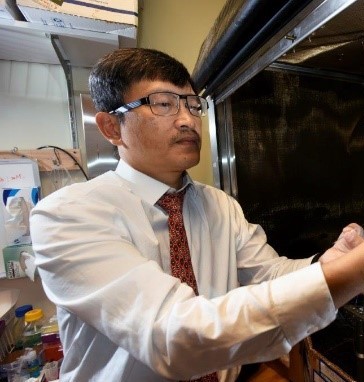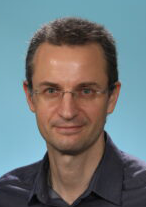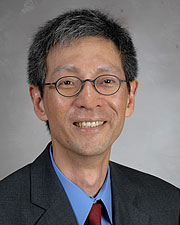Organized by Cullen Eye Institute and Department of Ophthalmology, Baylor College of Medicine
The Vision Club Seminar Series provides a platform to connect vision research investigators and clinicians for scientific discussion and research collaboration. The seminar series attracts vision research scientists from the Texas Medical Center as well as in the United States and around the world. The goal of this platform is to develop a rich academic environment, cultivate new scientific ideas and advance the frontier of vision research. Our monthly events are open to all members of vision research community and are generally held at 3 – 4 p.m. (unless otherwise specified) on the second Tuesday of every month.
Seminar Speakers 2021

Seminar Title: Retinal Phosphoinositides
Time: 3 p.m. via Zoom
Speaker Bio: Dr. Theodore Wensel is the Robert A. Welch Chair in Chemistry, chair of biochemistry at Baylor College of Medicine. His research focuses on vision research, including visual transduction, G protein-coupled receptors, phosphoinositide signaling, RGS proteins, biomembranes, ocular proteomics and gene repair.
Seminar Summary: Phosphoinositides, the phosphorylated forms of the membrane lipid phosphatidylinositol, play important roles in signal transduction and membrane trafficking. We have found that in rod cells, light exposure leads to dramatic increases in levels of phosphatidylinositol-3-phosphate (PI(3)P) and phosphatidylinositol-4,5-bisphosphate (PI(4,5)P2). We have knocked out the gene (Vps34 aka Pik3c3) encoding the Type III PI-kinase responsible for synthesis of PI(3)P in rods, cones, ON-bipolar cells and RPE cells. In all three cell types, development proceeds normally, but there are defects in autophagy, endosome processing and phagocytosis that lead to cell death. Surprisingly PI(3)P is not required for initiation of autophagy or phagocytosis, but is essential for fusion with lysosomes. PI(4,5)P2 is found in discrete patches in the plasma membrane of rod outer segments, rod inner segments, the outer nuclear layer, and peri-synaptic membranes. Its levels in the light are reduced in the absence of phototransduction, but the mechanism and functions of the light-induced changes remain under investigation. The type I PI-3 kinase responsible for synthesis of PI(3,4,5)P2 does not appear to be important for rod function or survival.

Seminar Title: The role of trophoblast glycoprotein in the retina
Time: 3 p.m. via Zoom
Speaker Bio: Dr. Ching-Kang Jason Chen is professor of ophthalmology and Alice R. McPherson Retina Research Foundation Endowed chair at Baylor College of Medicine. His research focuses on heterotrimeric G-proteins in vision, mechanisms and consequences of photoreceptor degeneration, retinal cell biology and circuitry and phototransduction.
Seminar Summary: Trophoblast glycoprotein (TPBG), recognized by a monoclonal antibody 5T4, is highly expressed in embryonic tissues and restricted in adults. In the retina, it is expressed specifically in rod bipolar cells and in an ON-OFF wide-field amacrine cell called TPBG-AC. We have made and characterized the Tpbg-/- mice and found in them a unique enhancement of photopic contrast sensitivity to certain spatial stimuli. This talk will cover our current working hypothesis and progress on the roles of TPBG in the retina.

Seminar Title: Population-specific mechanisms of retinal ganglion cell neuroprotection and axon regeneration
Time: 3 p.m. via Zoom
Speaker Bio: Dr. Nicholas Tran is an assistant professor of molecular and human genetics, Baylor College of Medicine, Houston, Texas.
Seminar Summary: Neurons in the CNS have limited ability to recover from axonal injury. Much focus has been placed on identifying strategies to protect damaged neurons and stimulate regrowth of axons. While many treatments have been identified, each typically only protects a fraction of neurons and fewer still regenerate their axons. Why do some neurons respond to treatment while others do not? We are applying single-cell transcriptomic approaches to determine how different populations of retinal ganglion cells (RGCs) are affected by injury and how they respond to different neuroprotective and regenerative interventions. We identify population-specific expression programs correlating with RGCs that are likely to degenerate, survive but not regenerate, or survive and regenerate. This work reveals potential gene targets for advancing the development of therapies of both optic neuropathies and acute nerve injuries like spinal cord injury.

Seminar Title: Combating drug resistance in age-related macular degeneration
Time: 3 p.m. via Zoom
Speaker Bio: Dr. Yingbin Fu is an associate professor of ophthalmology and Sarah Campbell Blaffer Endowed chair at Baylor College of Medicine, Houston, Texas.
Seminar Summary: Choroidal neovascularization (CNV), which accounts for 10-20 percent of AMD, is responsible for 80-90 percent of AMD-related blindness. Anti-VEGF therapies that target extracellular VEGF have revolutionized the treatment for CNV; however, it is estimated that up to 50 percent of patients have poor responses to this treatment. Different strategies have been tested to overcome this issue. However, no major breakthrough has been reported in combating anti-VEGF resistance. The mechanisms for anti-VEGF resistance are poorly understood. We explore the unique property of the apolipoprotein A-I (apoA-I) binding protein (AIBP) that enhances cholesterol efflux from endothelial cells and macrophages to thereby limit angiogenesis and inflammation to tackle anti-VEGF resistance in CNV. We show that laser-induced CNV in mice with increased age showed increased resistance to anti-VEGF treatment, which correlates with increased lipid accumulation in macrophages. The combination of AIBP/apoA-I and anti-VEGF treatment overcomes anti-VEGF resistance and effectively suppresses CNV. Furthermore, macrophage depletion in old mice restores CNV sensitivity to anti-VEGF treatment and blunts the synergistic effect of combination therapy. These results suggest that cholesterol-laden macrophages play a critical role in inducing anti-VEGF resistance in CNV. Combination therapy by neutralizing VEGF and enhancing cholesterol removal from macrophages is a promising strategy to combat anti-VEGF resistance in CNV.

Seminar Title: A paradoxical increase in visual sensitivity in a mouse model of retinal degeneration
Time: 3 p.m. via Zoom
Speaker Bio: Dr. Eduardo Solessio is associate professor of ophthalmology and visual sciences and neurosciences and physiology at SUNY Upstate Medical University, Syracuse, NY.
Seminar Summary: Various retinal degenerative diseases in humans minimally cause loss of retinal function, but can also cause a loss of retinal cells, and eventual blindness. In order to improve therapeutic strategies and treatment outcomes for these diseases, it is critical to understand the fundamental retinal and visual changes that occur early in retinal degenerative disease. In this presentation, I will use a mouse model of a human retinal disease to demonstrate an aspect that may develop during early retinal degeneration: an enhanced ability to detect flickering lights. I will also show that this surprising retinal gain-of-function is caused by a pathological acceleration of the temporal properties of rod photoresponses. Advanced rod dysfunction in human disease is currently diagnosed using relatively complicated tests employing full-field ERG and perimetry. Applying our method to humans to measure retinal or visual sensitivity to flickering lights could prove useful as a rapid test for early rod dysfunction in some forms of retinal degeneration.

Seminar Title: Deciphering Retinal Cell Fate Determination with Single Cell Omics
Time: 3 p.m. via Zoom
Speaker Bio: Dr. Graeme Mardon is James R. Davis chair in pathology and immunology, professor of molecular and human genetics at Baylor College of Medicine.
Seminar Summary: The Drosophila eye has been one of the most powerful animal model systems for deciphering molecular mechanisms of cell fate determination and development for more than 40 years. A landmark discovery reported in 1996 (Freeman) revealed that the Epidermal Growth Factor Receptor (EGFR) signaling pathway is both necessary and sufficient to trigger the differentiation of nearly all cell types in the Drosophila retina. This finding posed the question of how activation of a single pathway could trigger the differentiation of more than ten different cell types in the same tissue at the same time during development. More than a quarter century later, there has been little mechanistic progress in our understanding of this process. Given the fundamental importance of EGFR signaling throughout higher eukaryotes in cell differentiation, proliferation, and survival, it is of broad significance to unravel this conundrum. To this end, we have generated extensive single cell RNA-sequencing data on multiple stages of the developing Drosophila eye, as well single cell chromatin accessibility data (ATAC-seq). Integration of these data should lead to a better understanding of how the EGFR pathway is reiteratively used to regulate retinal cell fate determination.

Seminar Title: Vision for escape and pursuit
Time: 3 p.m. via Zoom
Speaker Bio: Dr. Daniel Kerschensteiner is professor in Department of Ophthalmology and Visual Science at Washington. University.
Seminar Summary: One interest of my lab to understand how the visual system detects and tracks salient stimuli in the environment to initiate and guide specific behaviors (i.e., visual neuroethology). Predator avoidance and prey capture are central selection pressures of animal evolution. Mice use vision to detect aerial predators and hunt insects. I will discuss studies from my group that identify specific circuits and pathways in the early visual system (i.e., the retina and its subcortical targets) mediating predator avoidance and prey capture in mice. Our results highlight the importance of subcellular visual processing in the retina and the alignment of viewing strategies with region- and cell-type-specific retinal ganglion cell projection patterns to the brain.

Seminar Title: T-box Transcription factors in the development of retinal neuronal subtypes
Time: 3 p.m. via Zoom
Speaker Bio: Dr. Chai-An Mao is assistant professor in Ruiz Department of Ophthalmology and Visual Science at the University of Texas McGovern Medical School.
Seminar Summary: We are interested in understanding the fundamental mechanisms regulating how diverse neuronal types in the central nervous system arise during development. In a mature mammalian retina, more than forty distinct types of retinal ganglion cells (RGCs) and sixty types of amacrine cells (ACs) have been described on the basis of their morphologies, functions, and molecular profiles. However, the cellular and molecular mechanisms that control the specification and differentiation of these diverse neurons remain unclear. This talk will discuss the roles of two evolutionarily conserved T-box containing transcription factors, Tbr1 and Tbr2, in the development of distinct subsets of RGCs and ACs.

Seminar Title: Sidestepping stem cells to restore sight
Time: 3 p.m. via Zoom
Speaker Bio: Dr. Chavala currently serves as a professor in the Department of Surgery at the Texas Christian University/University of North Texas Health Science Center School of Medicine in Fort Worth, Texas.
Seminar Summary: Up until now, researchers have replaced dying photoreceptors in animal models by creating stem cells from skin or blood cells, programming those stem cells to become photoreceptors, which are then transplanted into the back of the eye. Dr. Chavala’s team shows that it is possible to skip the stem-cell intermediary step and directly reprogram skins cells into photoreceptors for transplantation into the retina. The lab-made photoreceptors enabled blind mice to detect light after the cells were transplanted into the animals' eyes. The work was published April 15 in Nature. This is the first study to show that direct, chemical reprogramming can produce retinal-like cells. It provides a novel and faster strategy for developing therapies for retinal disorders caused by the loss of photoreceptors








